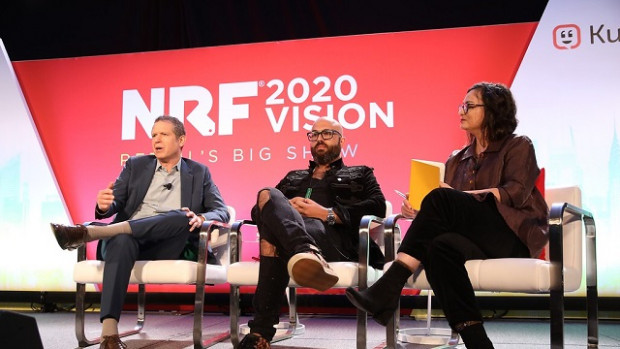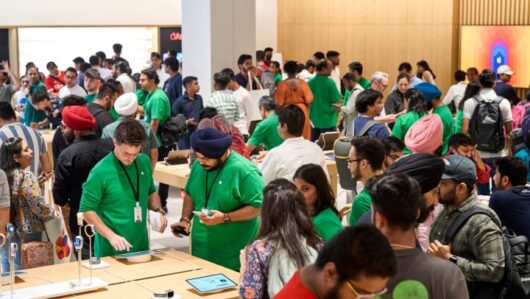
Nearly 40,000 people from 99 countries descended on the Javits Convention Center in New York City on Sunday, January 12, to attend the first day of the National Retail Federation’s (NRF) Big Show.
The theme for this year’s event, the biggest retail conference in the world, is vision – 20/20 vision, that is – and executives from the likes of Microsoft, Macy’s, Kohl’s, L’Oreal and Crate & Barrel, as well as numerous up-and-coming brands, took to the stage to share their thoughts on the future of retail.
Here are some highlights from the day:
What Kohl’s CEO Michelle Gass thinks about the future of the department store
“I think it’s hard to actually use the term ‘department store’ because what does that even mean anymore,” Michelle Gass, CEO of Kohl’s, a discount department store chain based in the US, said during one of the keynote sessions.
“I don’t think about Kohl’s as a very traditional department store. We’re not in a mall; we’re Kohl’s and we serve families.”
The question came after Gass acknowledged the company’s “disappointing” Christmas sales, with comparable sales down 0.2 per cent from 2018. But Gass said these results don’t reflect the full impact of all the changes that have been made at the company since she stepped up as CEO in May 2018, and she noted that recent initiatives, such as the partnership with Amazon to allow shoppers to collect their online orders in Kohl’s stores, are bearing fruit.
“I think the future of retail, and the kinds of things we sell, is really bright. It’s not going to be fantastic every day, we’re going to have our share of challenges – what business doesn’t?” she said.
“But as I look ahead, I believe the future for Kohl’s, and for retail, is very bright. But we’re all going to have to change and evolve and adapt.”
How Showfields and Area15 are reinventing the physical store
Showfields is a new department store in New York City that has been called the “most interesting store in the world” for its innovative retail-as-a-platform concept. Started by Tal Zvi Nathanel in 2018, it aims to make it as easy for direct-to-consumer [D2C] brands to open a physical store as it is for them to start selling online. In addition to showcasing dozens of brands in its four-storey, 15,000sqf department store, Showfields also features art exhibits, theatrical events and interactive experiences, which are constantly refreshed and open to the public.
Area15 is a – for lack of a better term – 120,000sqf mall in the middle of Las Vegas. But in addition to the usual mix of retail tenants, it dedicates a significant portion of its space to art and entertainment.
Nathanel and Dan Pelson, Area15’s COO, discussed the purpose of physical retail in 2020:
“From our perspective, the purpose of a physical location is the ability to connect and establish your brand attributes…all the things that [applied] 100 years ago still apply today,” Pelson said.
“It’s very difficult to make a connection with the customer through a platform like Amazon. From a brand perspective, that’s a utility play. How do you drive long term value?”
What D2C brands think about the rising cost of Facebook and Instagram
Three founders of female-led D2C brands – Nicole Gibbons, who started Clare, an online paint store, Amanda Johnson, who co-founded Mented Cosmetics, an online beauty brand targeting diverse skin tones, and Melanie Travis, who started Andie, an online swimsuit brand – discussed the rising cost of advertising on Facebook and Instagram.
While all three founders said it had become more expensive to acquire customers through these channels since the early days of their startups, they have responded to this change in different ways.
Gibbons and Johnson – with their businesses Clare and Mented, respectively – said they are now seeking ways to make Facebook and Instagram advertising work more efficiently. Since Mented has started selling through retailers, Johnson said they don’t have to advertise as frequently on Facebook and Instagram, since part of the customer journey now occurs in-store.
But Travis said Andie still considers Facebook and Instagram to provide the best bang for your advertising buck, even if it has become more expensive over the years.
“I’d love for there to be more platforms to acquire [customers], and the prices have gone up, but it’s still the best platform out there. Many other channels require a bigger upfront investment,” she said.
To keep costs as low as possible, Travis said Andie has brought all social media advertising in-house – it used to work with agencies – and has become really “scrappy” with using user generated content and influencers.
How Crate & Barrel is introducing its 58-year-old brand to a new generation
US homewares brand Crate&Barrel has been around for 58 years, but CEO Neela Montgomery says the company doesn’t assume it will be around for 58 more. Instead, she feels the business needs to prove its value and relevance to the next generation of customers every day.
“They expect you to [do something] unexpected,” she said in Sunday’s closing keynote, referring to the recent opening of an in-store restaurant and the company’s decision to collaborate with like-minded brands, including modern furniture brand CB2, gift registry site Zola and furniture rental business Furnish.
“There are advantages and disadvantages to those sorts of partnerships,” Montgomery said, as opposed to doing everything in-house. But so far, the decision to collaborate has paid off.
The company is gaining insights into millennials’ furniture shopping preferences through its partnership with Furnish, and hoping to turn the more than 175,000 couples that have added a Crate&Barrel product to their wedding registry through Zola into loyal customers.
“Increasingly a brand is what other people say about you, not what you say about yourself,” she said.
Come back tomorrow for more Big Show insights.
Heather McIlvaine traveled to NRF as a guest of Intel.





